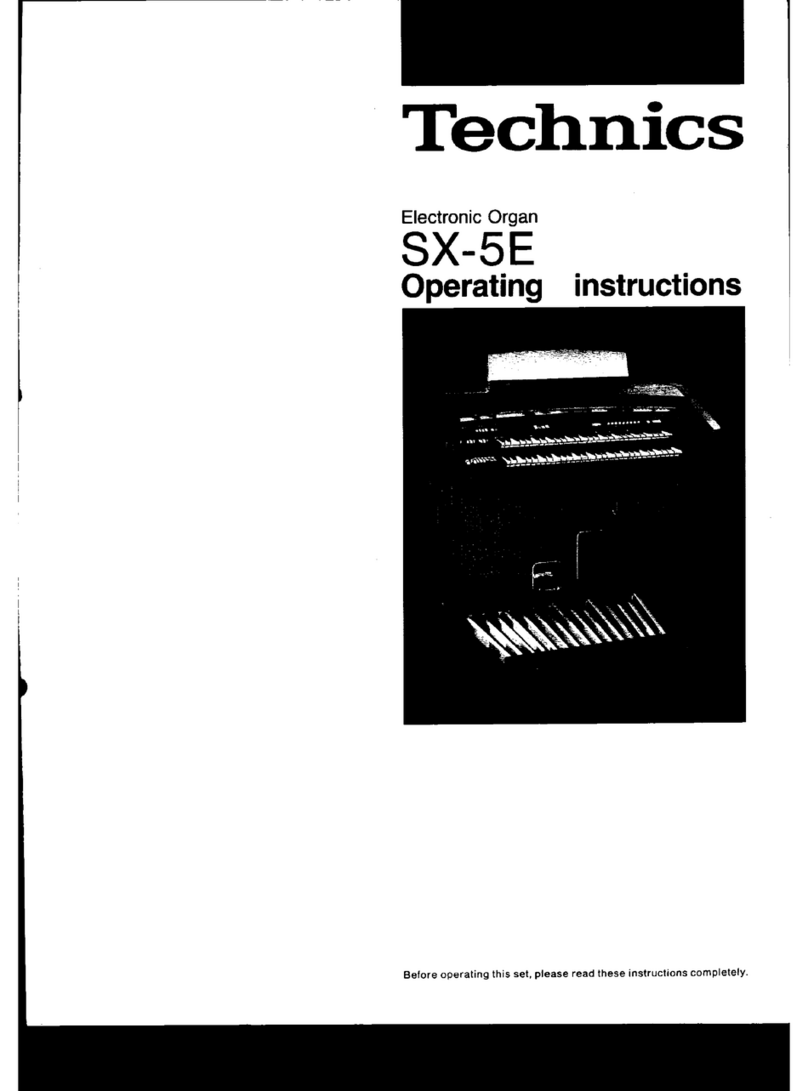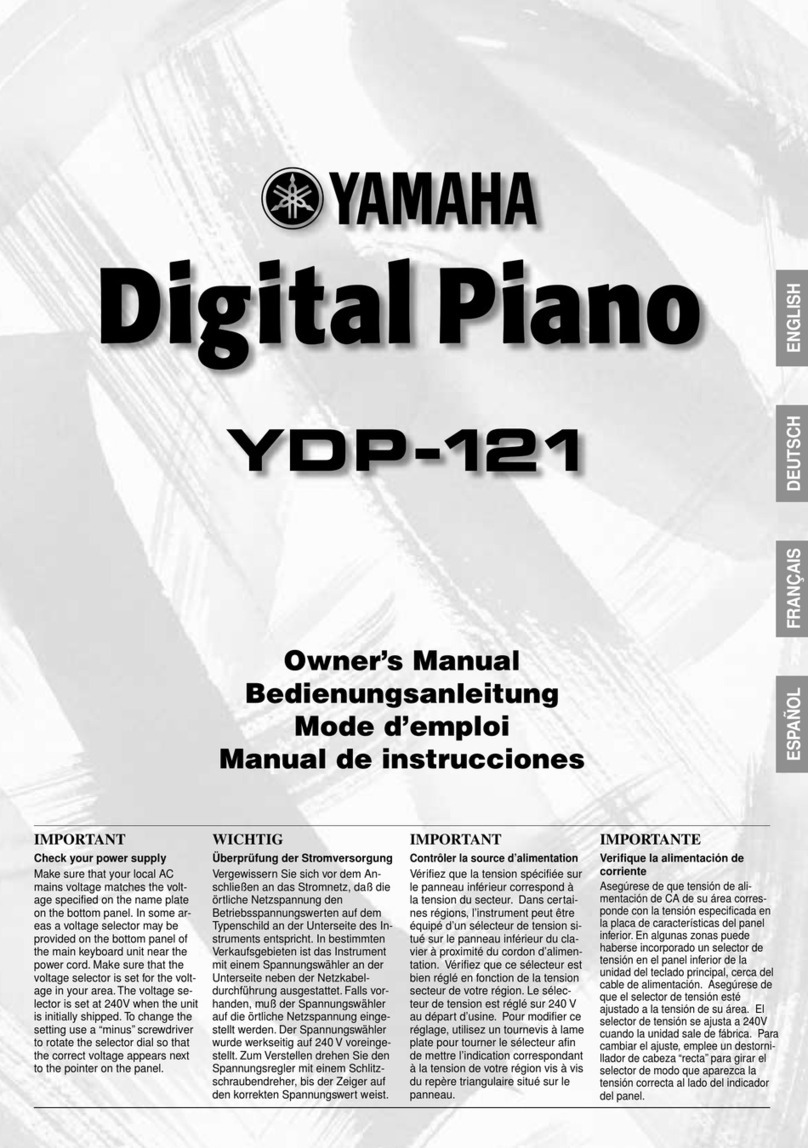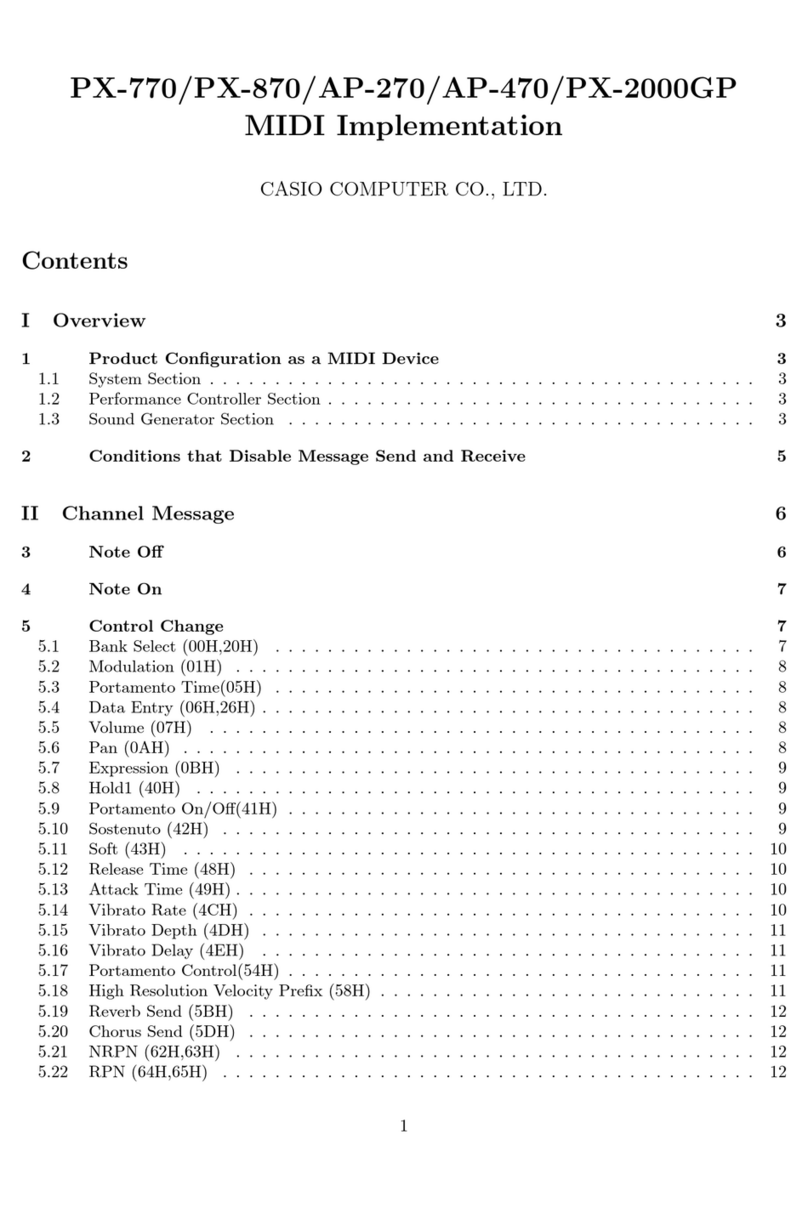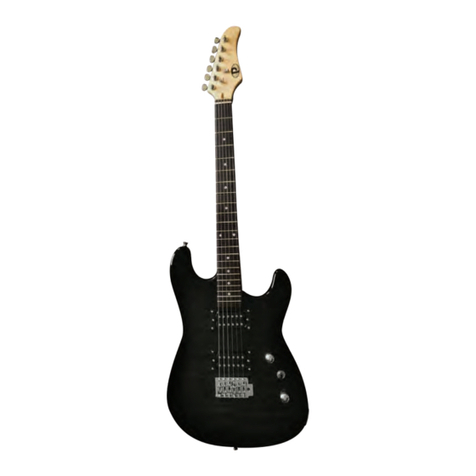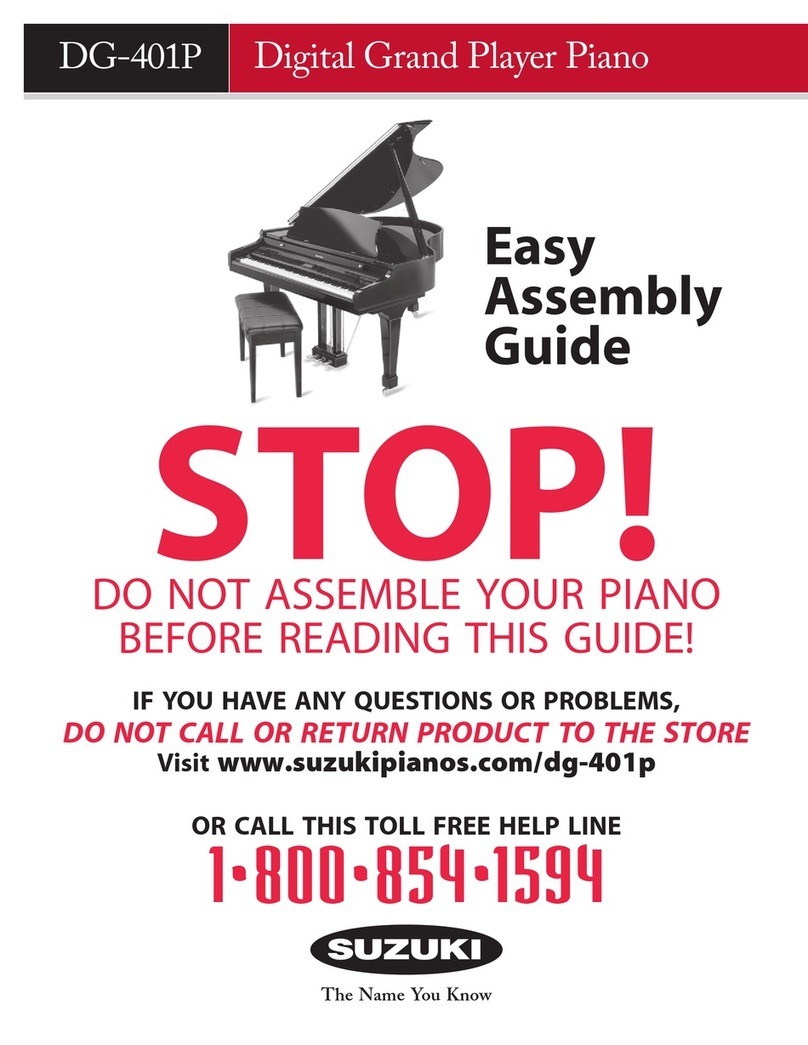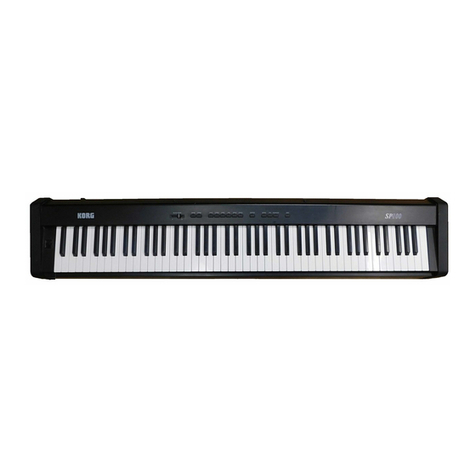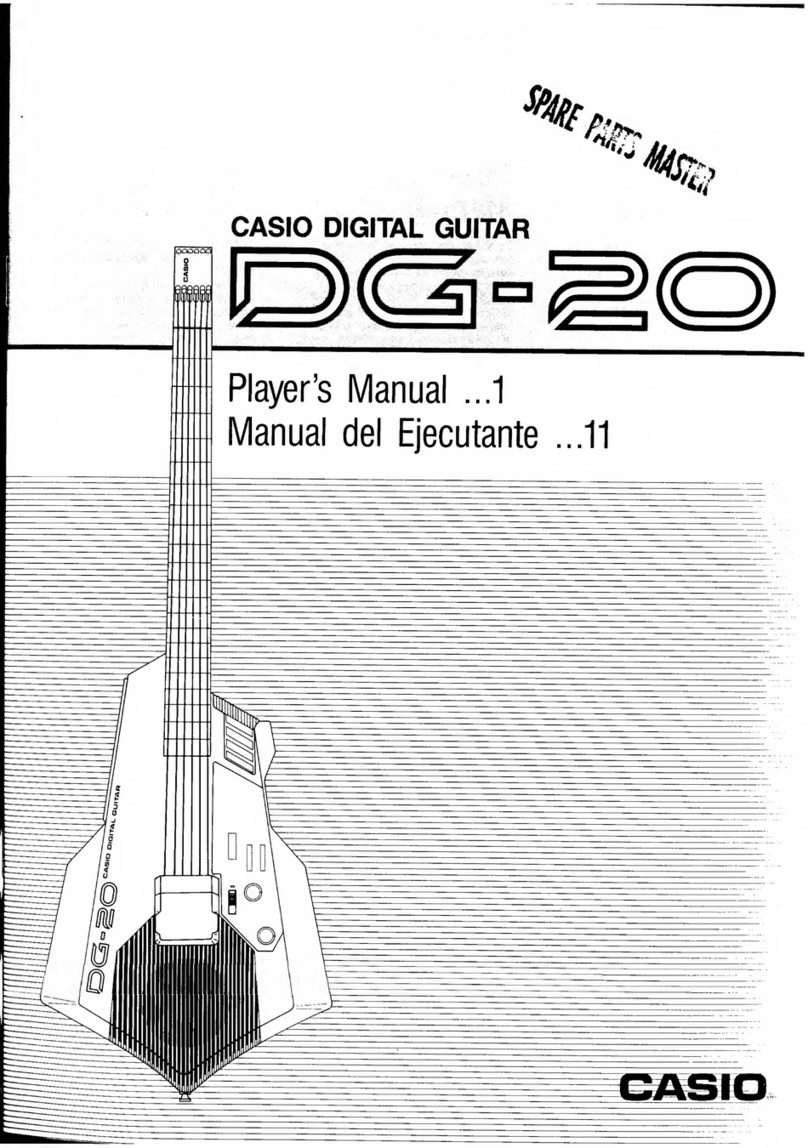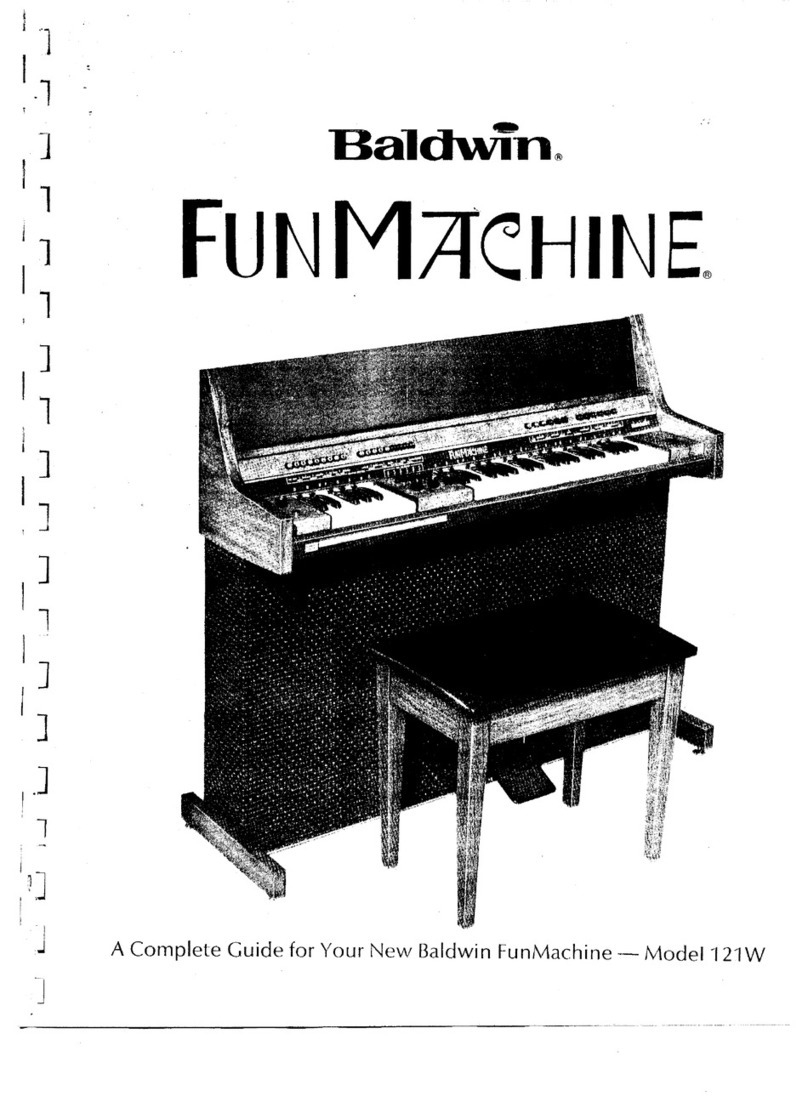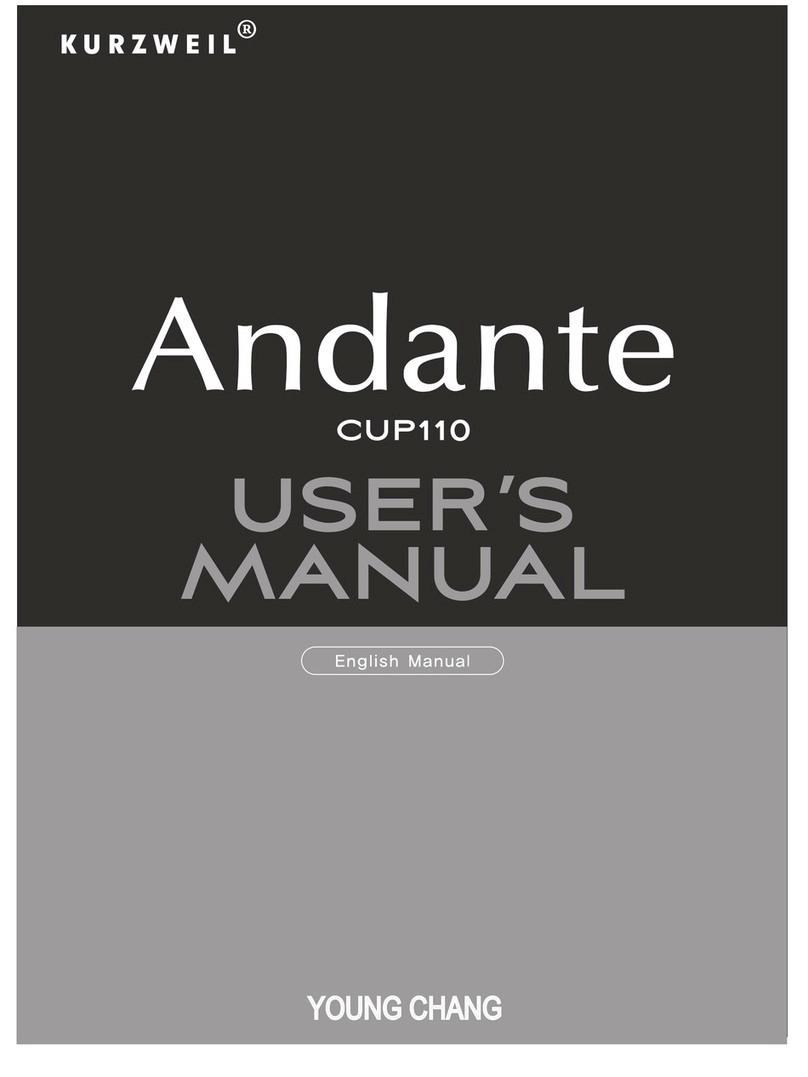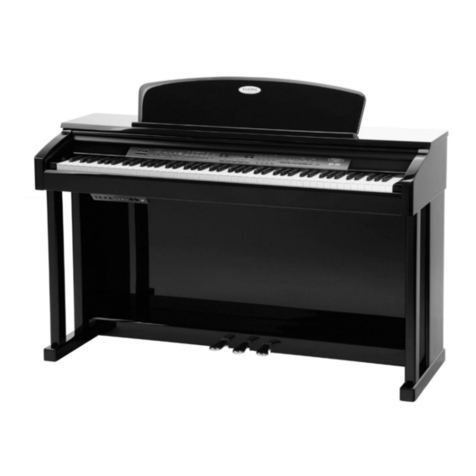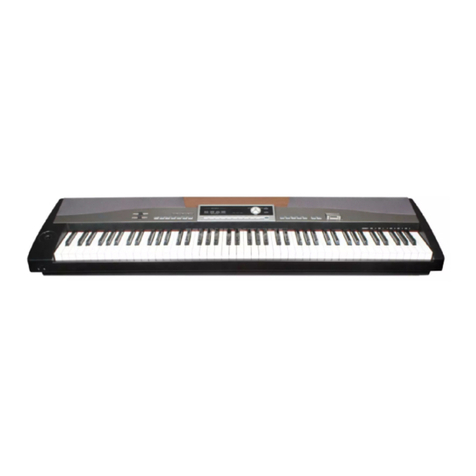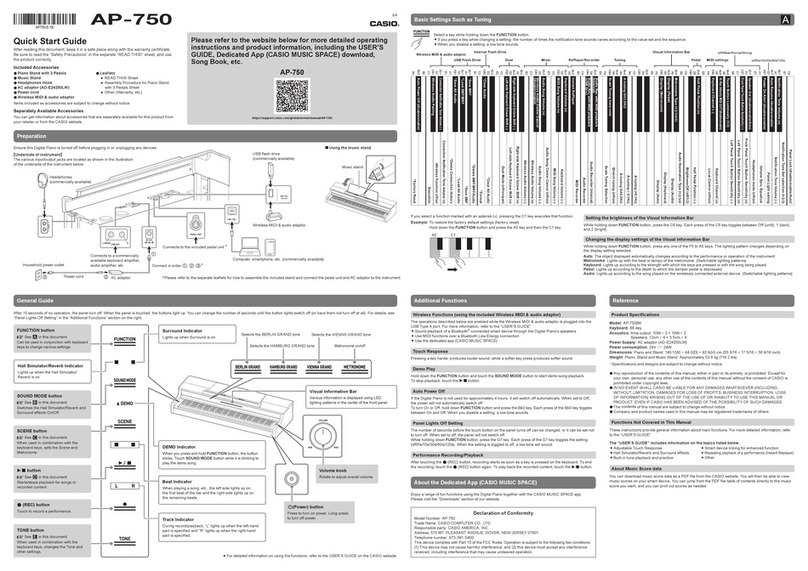Voce ELECTRIC PIANO User manual

Products Manuals FAQ Customer Support
VOCE® ELECTRIC PIANO™ PRODUCT MANUAL
CONTENTS
Introduction
Unpacking the Electric Piano
Front Panel Layout Diagram
Rear Panel Layout Diagram
Set-Up
Using The Electric Piano
Presets
MIDI OMNI ON Mode
Multi-timbral Mode
MIDI Controlled Effects
Specifications
Warranty
INTRODUCTION
The ELECTRIC PIANO is designed to provide the player with sounds, effects and most
importantly, the expressiveness of mechanical electric pianos. The timbre of the sounds created
by the ELECTRIC PIANO varies greatly and smoothly over the entire key velocity range. The
effects provided can be used to achieve the sounds heard in popular recordings of the past or
create new sound innovations.
The ELECTRIC PIANO is real easy to use. It requires absolutely no programming. There are front
panel rotary controls for volume, overdrive, effects rate and depth, transpose and preset. It has
built-in analog effects such as: Chorus, Tremolo, and Wah-wah. The Wah-wah effect can be
controlled by key velocity, modulation wheel or from an external foot controller.
There are 32 presets in the ELECTRIC PIANO. The first 17 are basic keyboard sounds without
effects and the remaining 15 presets are popular combinations of sounds and effects. The first 22
presets are selectable via the front panel: all 32 can be selected through MIDI. In addition, the
ELECTRIC PIANO can operate in three part multi-timbral mode for any three adjacent channels as
well as MIDI OMNI ON mode (all channels). There are high-level stereo audio outputs, CH2
output may be used to drive high-impedance stereo headphones. All this makes the ELECTRIC
PIANO very easy and intuitive to use.
UNPACKING THE ELECTRIC PIANO

Inside the Electric Piano shipping carton you will find the following:
Electric Piano unit
AC adapter
Owner's manual
MIDI implementation chart
Warranty card
Four rubber feet
Rack tray adapter screw & washer
Please return the warranty card soon after your purchase. The information you provide will allow
Voce to keep you informed about updates and new products.
FRONT PANEL
VOLUME: rotary volume control. Turning this control clockwise will increase the volume
level. Volume can also be controlled via MIDI control number 7.
OVERDRIVE: rotary overdrive control. Turning this control clockwise will increase the
overdrive (distortion effect) level .
RATE: rotary control for rate of Tremolo and Chorus effects. Turning this control clockwise
will increase the speed of the modulation for the Tremolo and Chorus effects. RATE can also
be controlled via MIDI. See the section on MIDI CONTROLLED EFFECTS for more information
DEPTH: rotary control for depth of Tremolo and Chorus effects. Turning this control
clockwise will increase the amount of modulation for the Tremolo and Chorus effects. DEPTH
can also be controlled via MIDI. See the section on MIDI CONTROLLED EFFECTS for more
information.
CHORUS: This push-button turns the Chorus effect on or off. The Chorus effect creates a
gentle swirling "doubling" sound for struck notes. The DEPTH and RATE controls are active
when this effect is used. The Chorus effect can also be enabled via MIDI. See the section on
MIDI CONTROLLED EFFECTS for more information.
TREMOLO: This push-button turns the Tremolo effect on or off. The Tremolo effect provides
a regular variation in volume between the two audio outputs ("ping-ponging"). The DEPTH
and RATE controls are active when this effect is used. The Tremolo effect can also be enabled
via MIDI, see the section on MIDI CONTROLLED EFFECTS for more information.
WAH-WAH ON: This push-button turns the Wah-wah effect on or off. The Wah-wah effect
provides real-time control over the ELECTRIC PIANO's analog filter. This resonant hi-pass
filter simulates the sound of a wah-wah effect pedal. This effect was popularly used with
Clavinet sounds.
WAH-WAH ON allows both the controller's modulation wheel and the external pedal input
on the ELECTRIC PIANO to control the Wah-wah effect. The Wah-wah effect can also be
enabled via MIDI, see the section on MIDI CONTROLLED EFFECTS for more information.
WAH-WAH AUTO: This push-button turns the automatic Wah-wah effect on or off. The
automatic Wah-wah effect causes the analog filter (described above) to be controlled by key
velocity. If WAH-WAH ON is also active, all three sources (modulation wheel, foot pedal, and

velocity) will control the filter. The WAH-WAH AUTO effect can also be enabled via MIDI, see
the section on MIDI CONTROLLED EFFECTS for more information.
TRANSPOSE: Used to change the musical key which the ELECTRIC PIANO will play. This
control is helpful for utilizing different ranges of notes on your keyboard especially if your
keyboard is 5 octaves or less.
MIDI: LED indicator lights up when ELECTRIC PIANO is turned on. The LED will flash off
briefly when the ELECTRIC PIANO receives MIDI transmissions from a MIDI controller.
PRESET: rotary preset selector. Allows selection of any one of the first 22 presets as
indicated by the positions marked 1 - 22. The position marked M selects multi-timbral mode
(see page 10). The position marked P allows the ELECTRIC PIANO to accept program
changes from a MIDI controller.
There are a total of 32 presets in the ELECTRIC PIANO. The first 22 can be selected through the
PRESET selector. All presets (the front panel 22 and the last 10) can be selected via program
changes from a MIDI controller.
REAR PANEL
POWER SWITCH: push-on / push-off switch
POWER JACK: The AC wall adapter connects to the ELECTRIC PIANO via this jack.
TUNING: rotary tuning control. Center detent is set to A440 standard tuning.
MIDI CH: 16 position rotary switch. Selects basic MIDI channel (channel 1 - 15 only) by
setting the switch to positions 1 - 15. MIDI OMNI ON mode is selected by setting the switch
to position 0.
FOOT PEDAL: 1/4" stereo type (tip, ring, sleeve) phone jack provided for foot pedal control
of the Wah-wah effect. A potentiometer type pedal or control voltage pedal may be used.
MIDI THRU: 5-pin DIN MIDI thru output. This MIDI output may be used to send a "carbon
copy" of the MIDI IN data to other modules.
MIDI IN: 5-pin DIN MIDI input. This MIDI input accepts MIDI data from a MIDI controller (i.e.
keyboard) or computer
CH1: channel 1 audio output.
CH2/PHONE: channel 2 audio output. Can also be used to drive high impedance stereo
headphones (> 600 ohm).
SET-UP

Refer to the diagram above for setting up the ELECTRIC PIANO.
To use your ELECTRIC PIANO, please follow these easy steps:
1. Connect a MIDI Controller
The ELECTRIC PIANO requires a MIDI connection to a MIDI device such as a MIDI keyboard,
digital piano, or computer in order for it to be played. Connect the MIDI out of this device to the
MIDI IN jack of the ELECTRIC PIANO using a MIDI cable.
2. Connect audio outputs to amplifier
The ELECTRIC PIANO provides two audio outputs for the stereo tremolo effect. Both CH1 and
CH2 outputs should be connected for stereo operation to a suitable audio system (i.e. digital
piano, stereo mixer / sound system). If mono audio operation is desired, connect CH1 to the
instrument amplifier (mixer etc.).
A set of high impedance (> 600 ohm) stereo headphones may be connected to the CH2 output.
Depending on the type of headphones used, it may be necessary to raise the level of the front
panel volume control. The headphone drive capabilities of the ELECTRIC PIANO may not be
suitable in some instances where high volume levels are desired.
3. Attach MIDI THRU Output (optional)
Useful in connecting more than one MIDI module in a daisy chain configuration. Use this output
for sending a "carbon copy" of the MIDI data appearing at the MIDI IN connector to other MIDI
devices.
4. Attach Foot Pedal (optional)

A potentiometer or control voltage foot pedal can be connected to this input to control the
Wah-wah effect. The Wah-wah effect must be turned on to make use of this effect. This 1/4"
stereo jack conforms to the following specification: Tip=control voltage input, Ring=510 ohm
resistor connected to 5 volts, Sleeve=ground. For a control voltage foot pedal use positive 0 to 5
volts connected to the Tip and the Sleeve is grounded.
5. Connect AC Adapter
The ELECTRIC PIANO requires an external AC adapter. Make sure that you first connect the small
barrel connector on the rear panel of the ELECTRIC PIANO before connecting the AC adapter to
the wall outlet.
6. Select the Basic MIDI Channel
Set the basic MIDI channel on the MIDI channel selector located on the rear panel of the
ELECTRIC PIANO. The basic MIDI channel should be the same as the channel that your MIDI
controller uses to transmit MIDI note on/note off and program change information to the
ELECTRIC PIANO.
Refer to the MIDI channel selection table on page 11 for a list of all valid MIDI channel
combinations.
7. Select tuning
A rotary control is provided in the event that it is necessary to change the tuning of the ELECTRIC
PIANO. The center detent position is A440 standard tuning. The pitch may be raised or lowered
by one semitone.
USING THE ELECTRIC PIANO
Built-in Demo
A built-in demonstration will play some of the various sounds and effects the ELECTRIC PIANO is
capable of creating. It may be activated by holding in the AUTO WAH-WAH button and
simultaneously turning the preset selector to the M position. The VOLUME and OVERDRIVE
controls will remain active during the demonstration. To exit the demonstration mode, turn the
preset selector to another position.
Playing
After connecting the ELECTRIC PIANO as explained in the Set-Up section, you will be ready to
begin playing. The ELECTRIC PIANO was designed to be very easy and intuitive to use. The
following is a brief description of the ELECTRIC PIANO's controls together with an explanation of
their usage.
Volume: Before powering-up the ELECTRIC PIANO, make sure that the volume level is turned all
the way down (volume control turned full counter clockwise). Power-up the ELECTRIC PIANO, the
MIDI LED should light up, then play some notes on your keyboard and gradually turn up the
volume to a comfortable listening level.
Overdrive: Overdrive may be used to simulate the sound of a tube amplifier driven into clipping.
It helps to realistically simulate the tube type Wurlitzer model 120 sound used by many "R & B"
and rock bands.

To adjust the amount of overdrive, simply play some notes and gradually turn the overdrive knob
clockwise. Notice how the amount of overdrive increases as you turn the knob. Adjust to taste.
Chorus: The ELECTRIC PIANO comes with a built-in chorus effect. This effect was popularly used
with the Rhodes electric piano popular during the 70's. The Rate and Depth controls allow the
player to "tweak" the effect to his or her taste. The LED indicator located near the Chorus push-
button shows the player when the effect is on. MIDI control changes can also be sent to turn on
the effect and set the rate and depth. This effect causes the polyphony to drop from 32 to 16
notes due to the assignment of 2 voices for each note.
Tremolo: An effect popularly used with the Wurlitzer electric piano. This sinusoidal amplitude
modulation gently varies the volume of the sound produced. The Rate and Depth controls allow
the player to set the amount and speed of the effect. This effect is stereo like the one found in
the suitcase Rhodes model electric pianos. Its variation in volume alternates between the stereo
audio channels. If a mono audio system is used be careful to use only one audio output from the
ELECTRIC PIANO because mixing the stereo signal to mono nullifies the Tremolo effect. The LED
indicator located near the Tremolo push-button shows the player when the effect is on. MIDI
control changes can also be sent to turn on the effect and set the rate and depth.
Wah-wah: A must for the Clavinet sound. This effect produces the same sound as when a
trumpet is played with a mute. Effect pedals created to produce this sort of effect were popular
for guitar during the late 60's. An analog filter inside the electric piano is used to create the Wah-
wah effect. It can be controlled from as many as three sources simultaneously: the keyboard's
modulation wheel, a foot controller plugged into the jack on the rear panel of the ELECTRIC
PIANO, and key velocity. The key velocity control is turned on by the Auto Wah-wah push-button
on the front panel. Modulation wheel and foot control are enabled by the Wah-wah On push-
button. All three control sources may be active at the same time. The LED indicators located near
the two Wah-wah effect push-buttons show the player which Wah-wah effects are on. MIDI
control changes can also be sent to turn on the two Wah-wah effects.
Transpose: Useful for changing the musical key which the ELECTRIC PIANO will play. This control
will allow you to utilize different ranges of notes on your keyboard. This is especially useful if
your keyboard has five octaves or less.
PRESETS
The ELECTRIC PIANO has 32 presets. The first 22 presets can be accessed through the preset
selector on the front panel; to access all 32 presets you must use a MIDI controller capable of
sending at least program changes 0 to 31. Set the preset selector to P when using your MIDI
controller to send program changes. This tells the ELECTRIC PIANO that all program changes will
now be set by your MIDI controller.
# Preset # Preset
1 WURLITZER 200 17 RMI
2 WURLITZER 120 18 WURLITZER 120 WITH TREMOLO
3 CLAVINET AC 19 CLAVINET WITH AUTO WAH-WAH
4 CLAVINET AD 20 RHODES NAIL POLISH WITH CHORUS

# Preset # Preset
5 CLAVINET BC 21 RHODES SUITCASE WITH TREMOLO
6 CLAVINET BD 22 CLAVINET WITH AUTO WAH-WAH AND CHORUS
7 CLAVINET II 23* PIANET "A" WITH TREMOLO
8 RHODES STAGE 24* DX EP1 WITH CHORUS
9 RHODES SUITCASE 25* DX EP2 WITH CHORUS
10 RHODES NAIL POLISH 26* CLAVINET WITH WAH-WAH
11 HARPSICHORD 8' 27* RHODES STAGE WITH CHORUS
12 HARPSICHORD 8',4' 28* WURLITZER 200 WITH TREMOLO
13 PIANET "T" 29* HARPSICHORD 8',4' WITH AUTO
14 PIANET "A" 30* HARPSICHORD 8',4' WITH CHORUS
15 DX EP1 31* DX EP1 WITH TREMOLO
16 DX EP2 32* RMI WITH AUTO WAH-WAH
* not accessible from the front panel switch—use MIDI program change to access.
MIDI OMNI ON MODE
When the ELECTRIC PIANO is in MIDI OMNI ON mode, it will respond to all MIDI channels. Any
NOTE ON/NOTE OFF information (within the note range utilized by the ELECTRIC PIANO),
program changes (if the PRESET selector is set to P), and specified control changes regardless of
MIDI channel will be recognized by the ELECTRIC PIANO in this mode.
To enable MIDI OMNI ON mode set the MIDI Channel selector on the rear panel to the "0"
position.
MULTI-TIMBRAL MODE
Multi-timbral Mode allows the ELECTRIC PIANO to accept MIDI information received on three (3)
adjacent channels as determined by the basic channel selected on the rear panel MIDI channel
selector. Program changes may be sent to the ELECTRIC PIANO to allow different presets to play
on each of the three MIDI channels simultaneously. Effect control change commands are global,
affecting the sounds produced by all three channels.
To use Multi-timbral mode:
1. Set the preset selector on the front panel to M. By doing this you are now telling the ELECTRIC
PIANO to accept MIDI data on the three channels selected in next step.
2. Select the three adjacent channels to be enabled by first setting the MIDI channel selector to
the basic (first of the three consecutive) MIDI channel. The basic MIDI channel and the next two
higher channels will be enabled (recognized). If channel 15 is selected, channels 16 and 1 will
also be enabled. See the chart on the next page.

OMNI ON mode and multi-timbral mode are mutually exclusive. OMNI ON mode takes precedence
over multi-timbral mode.
MIDI Channel Selection Table
Switch Position Basic MIDI Channel Multi-Timbral Channels
0 OMNI ON (ALL) N/A
1 1 1, 2, 3
2 2 2, 3, 4
3 3 3, 4, 5
4 4 4, 5, 6
5 5 5, 6, 7
6 6 6, 7, 8
7 7 7, 8, 9
8 8 8, 9, 10
9 9 9, 10, 11
10 10 10, 11, 12
11 11 11, 12, 13
12 12 12, 13, 14
13 13 13, 14, 15
14 14 14, 15, 16
15 15 15, 16, 1
MIDI CONTROLLED EFFECTS
The ELECTRIC PIANO allows control of several of its effects via MIDI control changes. The
following table lists the effects that can be controlled by MIDI, their MIDI control numbers, and
the associated control values:
Effect MIDI Control # Value
Rate 94 0 - 127, 0 = slowest
127 = fastest
Depth 91 0 - 127, 0 = least
127 = most
Chorus On/Off 80 0 - 63 = Off, 64+ = On
Tremolo On/Off 81 0 - 63 = Off, 64+ = On
Wah-wah On/Off 82 0 - 63 = Off, 64+ = On

Effect MIDI Control # Value
Wah-wah frequency
(when Wah-wah On) 10 - 127, 0 = lowest
127 = highest
Auto Wah-wah (On/Off) 83 0 - 63 = Off, 64+ = On
Note the MIDI control numbers are fixed, therefore to control the effects mentioned in the table
you will need a programmable MIDI controller. The various buttons, wheels, sliders, or pedals of
your MIDI controller must be assigned to the control number corresponding to the effect you
wish to control. It is advisable to determine the ability of your controller to be reprogrammed
before attempting the following:
Examples:
Controlling The Wah-wah Filter Frequency From A Continuous Controller:
Program the MIDI keyboard's controller (foot, slider, ect.) to send data on MIDI control number
1, just like the modulation wheel. The ELECTRIC PIANO recognizes controller number 1 as the
Wah-wah's filter frequency control.
Using a push-button to turn the Chorus effect on and off:
Let's say your MIDI controller has a push-button control that can be assigned to any MIDI
control number. Program the MIDI control number of the keyboard's push-button control to 80.
The ELECTRIC PIANO will interpret MIDI control number 80 as the Chorus ON/OFF control. Most
push-button MIDI controllers will output a value of 127 when in the "on" position and a value of
0 when in the "off" position. If your MIDI controller allows you to program the control value,
make sure you set it to a value between 0 and 63 for "off" and between 64 and 127 for "on".
Now you should be able to turn the Chorus effect on and off by pressing the push-button.
SPECIFICATIONS
CONTROLS: 4 rotary controls: VOLUME, OVERDRIVE, RATE, and DEPTH. 2 rotary selectors:
TRANSPOSE (+/- 2 octaves and semitonal) and PRESET (22 presets, multi-timbral mode,
program change enable). 4 push-buttons: CHORUS on/off, TREMOLO on/off, WAH-WAH
on/off, and AUTO WAH-WAH on/off. Rear: MIDI channel (OMNI ON mode), Wah-wah effect
foot switch connector, tuning control, and power switch
PRESETS: 32 total (22 front panel selectable)
POLYPHONY: 32 notes maximum, 16 notes minimum
AUDIO: 2 1/4" audio outputs provide stereo. +4 dBm nominal output level. CH2 output may
drive stereo headphones with >600 ohm impedance (used for test purposes only, not
suitable for driving headphones at high output levels).
MIDI I/O: MIDI IN and MIDI THRU
POWER: 12 volts AC @ 800 mA, 2.5mm connector
CABINET: Extruded aluminum chassis, aluminum front and rear, steel bottom panel
DIMENSIONS: 8" x 8" x 1.5"
WEIGHT: 4 lbs. excluding AC adaptor
